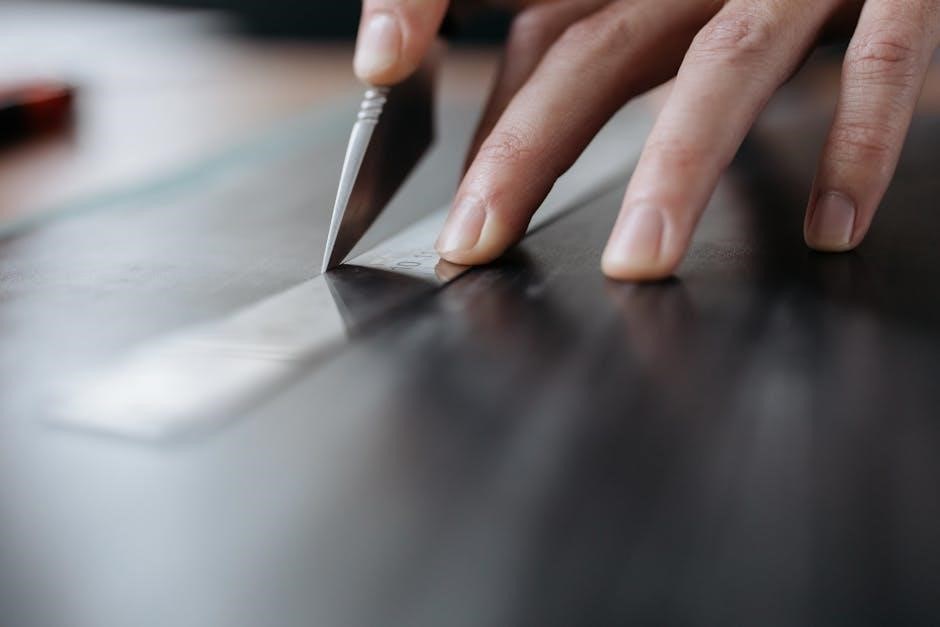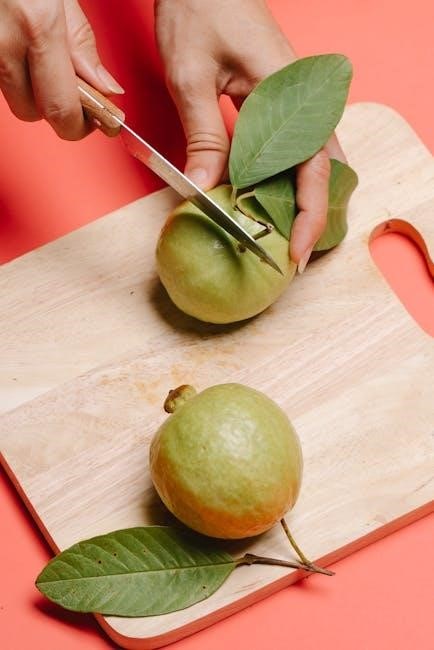A knife sharpener angle guide helps achieve precision and effectiveness in sharpening. Understanding the correct angles ensures optimal sharpness, considering factors like knife type and steel hardness. Essential for tool maintenance and safety, this guide provides insights into proper techniques and tools for consistent results.
Understanding the Basics of Knife Sharpening Angles
Knife sharpening angles determine the edge’s shape and performance. Typically, angles range from 10 to 40 degrees, with specific ranges suited for different knives. The angle refers to the edge’s incline relative to the sharpening surface. For most knives, the sharpening angle is halved, as it applies to both sides of the blade. Understanding this fundamental concept ensures proper sharpening, leading to better cutting performance and longer blade life. This foundational knowledge is essential for achieving a razor-sharp edge tailored to the knife’s intended use.
Why Sharpening Angle Matters for Knife Performance
The sharpening angle is critical for achieving optimal knife performance. It determines the blade’s edge geometry, directly impacting sharpness, durability, and cutting efficiency. A proper angle balances the knife’s sharpness with its ability to withstand wear and tear. Incorrect angles can result in a blade that is too delicate, prone to chipping, or insufficiently sharp for its intended use. The angle also influences how the knife interacts with different materials, making it essential for both utility and safety. Understanding and maintaining the correct sharpening angle ensures the knife functions as intended, enhancing its overall effectiveness and longevity.

Factors Determining the Sharpening Angle
The sharpening angle is influenced by knife type, steel hardness, and edge geometry. These factors ensure optimal sharpness and durability for the intended use of the blade.
Type of Knife and Its Intended Use
The type of knife and its intended use significantly influence the sharpening angle. For instance, chef knives require a moderate angle of 36-40 degrees for versatility and durability. Hunting knives, which need a strong edge for cutting tough materials, often use a steeper angle of 40-45 degrees. In contrast, pocket knives and fillet knives benefit from a shallower angle of 25-30 degrees for precision and sharpness. The intended use dictates the balance between edge retention and sharpness, ensuring the knife performs optimally for its specific task. This customization is crucial for achieving the desired cutting performance and longevity of the blade.
Steel Hardness and Its Impact on Sharpening Angle
Steel hardness plays a critical role in determining the ideal sharpening angle. Softer steels typically require a steeper angle, such as 40-45 degrees, to create a stronger, more durable edge. Harder steels, which are more brittle, benefit from shallower angles of 25-30 degrees to maintain sharpness without chipping. The hardness level directly affects how the blade holds its edge and responds to sharpening. Understanding the steel type ensures the sharpening angle is optimized for performance and longevity. This balance is essential for achieving a razor-sharp edge while preserving the knife’s structural integrity and functionality.
Knife Edge Geometry and Bevel Angle
Knife edge geometry significantly influences the sharpening process, particularly the bevel angle. A bevel is the angled portion of the blade that forms the cutting edge. The angle of the bevel determines the knife’s sharpness and durability. Most knives have a double bevel, with angles on both sides of the edge. The bevel angle is typically twice the sharpening angle, as the blade is sharpened on both sides. For example, a 20-degree sharpening angle results in a 40-degree bevel angle. Properly aligning the bevel during sharpening ensures an even edge and maximizes the knife’s performance. Understanding edge geometry is crucial for achieving optimal results.
How to Choose the Right Sharpening Angle
Selecting the proper sharpening angle ensures optimal knife performance. Consider blade type, usage, and steel hardness. Use guides or charts for precise angle selection, ensuring consistency and effectiveness.
General Guidelines for Selecting Sharpening Angles
Choosing the right sharpening angle involves considering the knife’s intended use and steel type. For everyday knives, angles between 36° and 40° are ideal, providing a balance between sharpness and durability. Softer steels benefit from steeper angles, typically around 40° to 50°, to prevent wear. Conversely, harder steels require lower angles, often between 20° and 30°, for a finer, more delicate edge. These guidelines ensure the blade holds its edge well while maintaining ease of sharpening. Always refer to a sharpening angle chart for specific recommendations tailored to your knife type.
Using a Knife Sharpening Angle Chart
A knife sharpening angle chart is an invaluable tool for determining the optimal angles for various knives. These charts typically outline recommended angles based on the knife’s intended use and steel type. For instance, everyday knives often use angles between 36° and 40°, while harder steels may require 20° to 30° for a finer edge. Softer steels, on the other hand, benefit from steeper angles, such as 40° to 50°. The chart also provides visual guidance, helping users maintain consistency and precision during sharpening. By referencing a sharpening angle chart, you can ensure your knife is sharpened effectively, balancing sharpness and durability.
Considering the Steel Type for Optimal Angles
The steel type significantly impacts the sharpening angle, as different steels require specific angles for optimal performance. Softer steels, which are more prone to wear, benefit from steeper angles (around 40° to 50°) to enhance durability. Harder steels, being more brittle, are best sharpened at shallower angles (typically 20° to 30°) to avoid chipping. A general rule is that softer steels use steeper angles, while harder steels require lower angles for a finer, more delicate edge. Always consider the steel hardness when selecting the sharpening angle to ensure the knife’s edge retains its sharpness and withstands use. This balance is crucial for achieving the desired cutting performance.
Tools for Maintaining the Correct Sharpening Angle
Essential tools include sharpening angle guides, digital angle measurement devices, and stones with built-in markers. These tools ensure precision, helping maintain consistent angles for optimal knife sharpness and longevity.
Using a Sharpening Angle Guide
A sharpening angle guide is a crucial tool for maintaining precision during the sharpening process. It helps users achieve consistent angles, ensuring optimal sharpness and edge durability. By aligning the guide with the knife’s edge, sharpening becomes more efficient and less error-prone. Digital angle cubes or adjustable guides are popular choices, offering precise measurements for various knife types. For beginners, these tools provide a learning curve, while experienced users appreciate their reliability. Regular use of an angle guide prevents over-sharpening and maintains the knife’s intended geometry. Whether for chef knives or pocket knives, a guide ensures a razor-sharp edge every time, enhancing both performance and safety.
Sharpening Stones with Built-In Angle Markers
Sharpening stones with built-in angle markers are designed to simplify the sharpening process by providing visual guides for maintaining consistent angles. These markers, often etched or printed on the stone’s surface, indicate common sharpening angles such as 20°, 25°, or 30°. This feature is particularly useful for beginners, as it helps them learn and replicate the correct angles. Experienced users also benefit from the added precision, ensuring their strokes remain consistent. The markers eliminate guesswork, allowing for more efficient sharpening and better edge retention. By aligning the knife’s edge with the markers, users can achieve professional-grade results with minimal effort, making these stones a valuable tool for anyone serious about knife maintenance.
Digital Angle Measurement Tools for Precision
Digital angle measurement tools offer unparalleled precision for knife sharpening. These high-tech devices, such as angle cubes or digital sensors, provide real-time feedback on the sharpening angle. By attaching to the knife or sharpening tool, they ensure consistent and accurate angles, minimizing errors. Some advanced models use Bluetooth or orientation sensors to monitor angles, offering a modern approach to traditional sharpening. These tools are ideal for enthusiasts and professionals seeking flawless results; While they may require initial setup or calibration, their ability to maintain precise angles makes them a valuable investment for achieving razor-sharp edges consistently. They cater to both novice and experienced users, ensuring optimal performance across various knife types and steel hardness levels.

Techniques for Sharpening at the Correct Angle
Mastering sharpening techniques involves maintaining the correct angle with steady strokes, using guides or digital tools for precision, and adapting methods for manual or electric sharpeners.
Manual Sharpening Techniques
Manual sharpening requires skill and patience. Start by positioning the knife at the desired angle, using a guide if needed. Light, consistent strokes are key to avoiding uneven edges. Maintain control throughout the process to ensure precision. For optimal results, sharpen on a stable surface, such as a whetstone, and check progress regularly. Proper technique ensures a sharp, durable edge tailored to the knife’s intended use. This traditional method allows for greater customization and is ideal for those seeking precise control over the sharpening process.
Using Electric Knife Sharpeners
Electric knife sharpeners offer convenience and efficiency. They typically feature preset angles, ensuring consistent results. Simply insert the knife into the slot and let the motor guide the sharpening process. This method is ideal for maintaining straight edges and is often faster than manual sharpening. However, it requires careful selection of the correct angle setting to match the knife’s needs. Regular maintenance of the sharpener is essential to prolong its effectiveness. Electric sharpeners are a great option for those seeking quick, precise sharpening with minimal effort, making them a popular choice for both home and professional use.
Maintaining Consistency in Sharpening Angles
Maintaining consistent sharpening angles is crucial for achieving a razor-sharp edge. Using an angle guide or digital tool helps ensure precision. Start by setting the desired angle and hold the knife firmly. Apply light, steady strokes, moving from heel to tip. Check the angle periodically to avoid deviations. For manual sharpening, practice is key to developing muscle memory. Electric sharpeners with preset angles simplify this process. Always maintain the sharpener itself to ensure accuracy. Consistency in angle and stroke pattern guarantees a sharp, durable edge, enhancing the knife’s performance and longevity. Regular practice and the right tools make maintaining consistent angles easier over time.
Common Mistakes to Avoid
Avoid sharpening at the wrong angle, using inconsistent strokes, or sharpening insufficiently. These mistakes can lead to a dull edge, reducing the knife’s performance and longevity significantly.
Sharpening at the Wrong Angle
Sharpening at the wrong angle is a common mistake that can significantly reduce a knife’s performance. Using too low an angle may result in a blade that is too fine and prone to breaking, while too high an angle can make the knife difficult to sharpen and less effective for cutting. The ideal angle depends on the knife type and its intended use, with most knives requiring a total angle of 20 to 40 degrees. To avoid this error, use a digital angle cube or sharpening guide to maintain consistency and precision during the sharpening process. This ensures the edge is neither too delicate nor too blunt, optimizing the knife’s functionality and longevity.
Inconsistent Strokes and Their Effects
Inconsistent strokes during sharpening can lead to an uneven edge, reducing the knife’s sharpness and performance. Uneven pressure or varying angles create a blade with some areas sharper than others, making it less effective for cutting. This inconsistency also weakens the edge, causing it to dull faster. To avoid this, maintain steady, controlled movements and use a sharpening guide to help keep strokes uniform. Regular practice improves technique, ensuring a consistent edge that maximizes the knife’s cutting ability and extends its lifespan. Inconsistent sharpening not only wastes time but also compromises the knife’s overall functionality, making it essential to develop a steady hand and precise strokes for optimal results.
Insufficient Sharpening and Its Consequences
Insufficient sharpening leaves the knife edge dull and ineffective, making tasks more difficult. A dull blade requires more force, increasing the risk of accidents and fatigue. It also leads to poor cutting performance, tearing materials instead of slicing cleanly. Over time, inadequate sharpening can damage the knife’s edge, creating micro-tears and reducing its lifespan. Regular and proper sharpening is essential to maintain sharpness, safety, and efficiency. Neglecting this step results in a tool that underperforms, making it unreliable for critical tasks. Ensuring the knife is sharpened adequately is crucial for both functionality and longevity, preventing the need for frequent repairs or replacements.

Advanced Tips for Experienced Users
Experienced users can refine their technique with micro-beveling for enhanced sharpness and adjust angles for specialty knives. Regular tool maintenance ensures precision and longevity, optimizing results.
Micro-Beveling for Enhanced Sharpness
Micro-beveling is an advanced technique that involves creating a small, secondary bevel near the knife’s edge to enhance sharpness and durability. This method allows for precise control over the blade’s geometry, ensuring a razor-sharp edge. By applying a micro-bevel, users can maintain the knife’s primary angle while refining the edge for better performance; This technique is particularly useful for high-carbon steel knives, as it helps prevent chipping and extends the life of the edge. Experienced users often combine micro-beveling with regular sharpening to achieve optimal results. Proper tools, such as a sharpening stone or diamond steel, are essential for executing this technique effectively.
Adjusting Angles for Specialty Knives
Specialty knives, such as fillet, serrated, or hunting knives, often require adjusted sharpening angles to suit their specific functions. For instance, fillet knives benefit from a narrower angle for precision cuts, while serrated knives may need a slightly steeper angle to maintain their toothed edge. Hunting knives, designed for durability, typically use a broader angle for strength. Understanding the intended use of the knife is key to determining the optimal angle. By tailoring the sharpening angle to the knife’s purpose, users can enhance performance and extend the blade’s life. Always research the recommended angle for your specific knife type to achieve the best results.
Maintaining the Sharpening Tool Itself
Proper maintenance of sharpening tools is crucial for consistent results. Regularly clean sharpening stones or electric sharpeners to remove metal particles and debris. For whetstones, flatten them periodically to ensure even sharpening. Electric sharpeners should have their wheels or belts replaced when worn. Store tools in a dry, protected environment to prevent rust or damage. Additionally, sharpening angle guides may need occasional alignment checks to ensure accuracy. By caring for your sharpening tools, you extend their lifespan and maintain precision in your knife sharpening process. Regular maintenance ensures your tools remain effective and reliable for achieving the perfect edge every time.

Frequently Asked Questions
Common questions include determining the ideal sharpening angle, frequency of sharpening, and maintaining consistency. Tips on tool selection and technique refinement are also frequently discussed.
What is the Ideal Sharpening Angle for My Knife?
The ideal sharpening angle varies depending on the knife type and its intended use. For most knives, a 36-40 degree angle is common, but harder steels may require lower angles for durability. Chef knives often use 20-30 degrees, while hunting knives might use steeper angles for tougher tasks. The angle is typically half the total cutting edge angle. Always consider the knife’s steel hardness and intended use. Using a sharpening guide or angle chart can help determine the perfect angle for your specific blade. Proper angle selection ensures a sharp, durable edge tailored to your knife’s purpose.
Can I Use the Same Angle for All My Knives?
No, using the same angle for all knives is not recommended. Different knives have varying purposes, steel hardness, and edge geometries, requiring specific sharpening angles. For example, chef knives benefit from lower angles for sharpness, while hunting knives may need steeper angles for durability. Using a single angle for all knives can lead to suboptimal results, such as reduced sharpness or edge durability. Always consider the knife’s intended use and steel type when selecting the sharpening angle. A sharpening guide or angle chart can help determine the best angle for each blade, ensuring peak performance and longevity.
How Often Should I Sharpen My Knife?
The frequency of sharpening depends on the knife’s usage and type. Knives used daily, like chef knives, may need sharpening every 1-3 months, while less frequently used knives, such as hunting knives, may only require sharpening once a year. Signs that your knife needs sharpening include difficulty cutting and visible dullness. Lightly used knives, like pocket knives, can often go 2-6 months between sharpenings. Regular maintenance, such as honing with a steel, can extend the time between full sharpening sessions. Always sharpen before the edge becomes excessively dull, as this reduces the effort and risk of damaging the blade during sharpening.
Case Studies and Examples
Explore real-world applications of knife sharpening angles through specific case studies. Learn how to sharpen chef knives, hunting knives, and pocket knives effectively with detailed examples and insights.
Sharpening a Chef Knife
A chef knife typically requires a sharpening angle of 20 degrees per side, totaling 40 degrees for a sharp, durable edge. Start by positioning the knife at the correct angle using a guide or steel. Light, consistent strokes maintain the edge geometry. For a Straight Edge (Western-style), use a push stroke, while a curved edge (Asian-style) may require a pull stroke. Avoid applying too much pressure, as this can damage the edge. Repeat strokes evenly on both sides until achieving the desired sharpness. Regular maintenance with a honing steel helps preserve the edge between sharpening sessions. Proper technique ensures longevity and optimal performance for your chef knife.
Sharpening a Hunting Knife
Hunting knives require a sharper, more durable edge due to their heavy use in cutting and skinning. A sharpening angle of 30-40 degrees is ideal, with each side sharpened at 15-20 degrees. Start by using a coarse sharpening stone to remove nicks and establish the edge, then finish with a fine stone for polish. Maintain consistent pressure and angle throughout the process. A steel or angle guide can help maintain precision. For serrated edges, focus on the straight portions and lightly hone the serrations. Regular sharpening ensures reliability in the field. Proper technique prolongs the knife’s life and enhances its performance for demanding outdoor tasks.
Sharpening a Pocket Knife
Pocket knives, often used for everyday tasks, require precise sharpening to maintain their utility. Typical sharpening angles range from 15 to 30 degrees, depending on the blade’s hardness and intended use. For straight-edge pocket knives, start with a coarse sharpening stone to establish the edge, then refine with a fine stone. Serrated blades may need specialized tools or careful strokes to avoid damaging the serrations. Use a sharpening guide to maintain consistent angles, especially for smaller blades. Light, controlled strokes are key to avoiding over-sharpening. Regular touch-ups keep the knife reliable for daily use, ensuring it remains sharp yet safe to carry. Proper technique balances sharpness and durability, essential for a tool meant for portability and convenience.
Understanding and applying the correct sharpening angles is crucial for optimal knife performance and longevity. Consistency and patience are key to achieving professional results effectively.
Understanding the correct sharpening angles is essential for maintaining knife performance and longevity. The ideal angle depends on the knife type, steel hardness, and intended use. Softer steels require steeper angles, while harder steels benefit from lower angles. Consistency in sharpening strokes ensures even edge wear. Tools like angle guides and digital measuring devices enhance precision. Regular sharpening prevents dullness and extends blade life. Advanced techniques, such as micro-beveling, can further refine sharpness. Proper maintenance of sharpening tools is also critical for consistent results. By mastering these principles, users can achieve razor-sharp edges tailored to their specific needs.
Final Tips for Effective Knife Sharpening
Always maintain patience and consistency when sharpening to avoid uneven edges. Use the appropriate angle guide for your knife type to ensure precision. Check the edge frequently to prevent over-sharpening. Store knives properly to maintain sharpness. Tailor sharpening angles to the specific steel hardness and intended use. Regularly clean and maintain sharpening tools for optimal performance. Practice makes perfect—refine your technique over time. By following these tips, you can achieve and maintain razor-sharp edges, extending the life of your knives and enhancing their functionality.